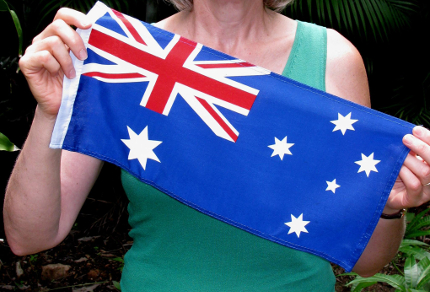
Ross River Parkway, Townsville (© Magi Nams)
There was wind this morning, blessed wind that swept over the Ross River Parkway, refreshing me as I ran and seeming to wipe away Townsville’s summer humidity. Drizzle speckled my skin and clothes as I ran and walked to Aplin’s Weir and then home again on the Annandale side, a total distance of 8 kilometres. Today, I did 60 minutes of 5 minutes running/1 minute walking, and I felt freer, my legs looser. After yesterday’s downpours, the river flats were once again tidal lagoons. A fleet of pelicans rode the flooded water, and masked lapwings stood at its border. A disgruntled-sounding sulphur-crested cockatoo flew over my head and squawked what sounded like a definite insult. I didn’t care. Leaving the house in the darkness, I had escaped the heat, the forecast heavy rain, and had beaten 8 kilometres of parkway. It felt good.
Later in the morning, I delved into the issue of Australia’s Stolen Generations. Until I saw the movie Australia last year, I’d never heard of the Stolen Generations. Near the movie’s opening, the mixed-race boy Nullah said that he was neither black nor white, but rather a half-caste or ‘creamy.’ He felt as if he belonged to no one. During the movie, Nullah escaped attempts to be captured by the Northern Territory police and taken to the church mission on Mission Island. Later, he was taken forcibly to the mission, but the fictional movie ended happily when he went to live with his English benefactress on her cattle station.
On the Air New Zealand flight from San Francisco to Auckland, I watched the movie The Rabbit-proof Fence, which also dealt with Australia’s Stolen Generations. Based on a true story, it chronicled the kidnapping of three mixed-race girls from their mothers, their impoundment at a government camp designed to force them into white servitude, and their subsequent escape and 9-week, 1600-kilometre trek – much of it guided by a fence erected to exclude rabbits from settlements – to return to their mothers. The eldest of the girls, a teen named Molly Craig, in real life was taken from her mother twiceand twice escaped the government camp and trekked that incredible distance home.
The period of the Stolen Generations was one of institutionalized racism in Australia. From 1909 to 1969, it was official government policy that Aboriginal and Torres Strait Islander children who were not of full blood could be forcibly taken from their families without parental consent or court order.1 Reports I read stated that the policy was also practiced unofficially before and after those years, finally ending in the early 1970’s.1,2 The child removals were, ironically, managed by a government agency called the Aborigines Protection Board and were part of the government’s White Australia and assimilation policies.1 In the case of Aboriginals and Torres Strait Islanders, the policy was intended to ‘breed out’ the Aboriginal race, which was considered inferior.1
Children taken from their families were brought up by whites and taught to abandon their Aboriginal heritage.1,2 Many suffered devastating emotional trauma, as did their family members.1 Some suffered physical and sexual abuse at the hands of those who were responsible for them, and many were deprived of all contact with their family members.1 Although numerous records were lost, it has been estimated that 100,000 children were taken from their families under this government policy.1
On May 26, 1997, the Bringing Them Home Report, which summarized a national inquiry into the separation of Aboriginal and Torres Strait Islander children from their families, was tabled in the Australian parliament.1 It outlined the flawed racial assumptions about the ‘benefits’ that would result from the separation policy and described the devastation suffered by the Stolen Generations and their families.1,2 The Australian Prime Minister at the time, John Howard, who had been in cabinet during the 1960’s when the removal policy was in effect, refused to issue an official apology.1 However, on February 13, 2008, the new PM Kevin Rudd, who is still in power today, apologized on behalf of the Australian government to all of the Stolen Generations members and their families.1
There are strange ironies associated with the removal policy. One is that some of the people involved in drafting it may actually have thought separation would provide those mixed-race children with a better future than they would otherwise have had. Another is that, right here and now in modern Australia, there are members of the Stolen Generations walking the streets who could be as young as in their 30’s.
References:
1. Reconciliaction Network. Stolen Generations Fact Sheet. July 28, 2007. © 2010. Accessed 19- Feb-2010. http://reconciliaction.org.au/nsw/education-kit/stolen-generations/#forced
2. European Network for Indigenous Australian Rights. The stolen generations. ENIAR © 1997-2009 http://www.eniar.org/stolengenerations.html


